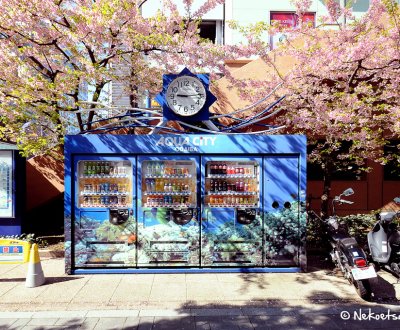Drinks Vending Machines in Japan
The n°1 of Vending Machines
Called jidohanbaiki, or just jihanki, vending machines can be found everywhere in cities and villages all over Japan. Japanese people use them every day to buy cool drinks in summer or hot ones in winter. Vending machines also sell many other items such as cigarettes or newspapers.
It cannot be said enough: summer in Japan is hot, especially in the capital (a feeling exacerbated by the ubiquitous concrete) with a damp and stifling weather from July, and the end of the rainy season tsuyu ☔️, to September. On average, temperatures go as high as 30°C (86°F) with a 70% humidity during this period. So how do the Japanese manage?
Saying that drinks vending machines are EVERYWHERE in Japan is quite the understatement: you’ll find them at hotels 🏨, in ryokan inns, on the train 🚅 stations platforms, on motorways service areas, in both cities and countryside, and even at the top of Mount Fuji 🗻! And it is not unusual to find lines of several vending machines in the streets, sometimes every 100m! In 2020, there was 1 machine for 30 inhabitants in Japan, that is to say about 4,05 million of vending machines in the archipelago (all types of vending machines). While their number has been decreasing over the last few years due to the decline in population and the increased competition of konbini, it stills shows how much this consumption habit is deeply ingrained in the population, since the end of the Taisho Era (1912 - 1926).
Vending machines are unavoidable items of the Japanese dayly life and are called jidohanbaiki (shortened jihanki). They were imported in Japan in the beginning of the Meiji Era (1868 - 1912) from Western countries that already used similar devices. Their used peaked in 2000 as the archipelago counted overall 5,6 millions vending machines for a gross revenue of about ¥5,700 billion (~36.5 billions dollars).
A daily use for every one
More than anywhere else in the world, vending machines are very popular and the reasons for this national passion can be explained by:
- Japan’s relative safety, with a vandalism rate so low it allows the installation of vending machines on public thoroughfare.
- The archipelago’s distinctive seasons, with almost tropical summers prompting frequent hydration; and cold and dry winters during which a hot drinks helps warming up.
- Japanese people’s fondness for robotics in general, that is put to use in the most trivial daily situations.
- These machines’ amazing efficiency as they are always available: no need to go to a store looking for a product and talking to a cashier. With the machine, purchasing is available 24/7 and immediately.
- An almost infinite choice, especially in drinks vending machine, with water, soft drinks, tea / coffee (hot or cold), fruit juices, energy drinks, and even unusual items like corn soups or azuki (red bean paste) soups.
- Relatively affordable prices, on average from ¥80 (~US$0.51) to ¥160 (~US$1.02) for a can or a small bottle.
- The permanent demand in the urban and densely populated areas: 93% of the 126 millions inhabitants live in the cities, mostly gathered on the coastline and in a few plains.
- An inexpensive starting investment, accessible to everyone. In residential areas, some machines are indeed directly managed by the inhabitants. This type of business is by the way encouraged by nonrestrictive town-planning regulations, a low consumption of energy and a dynamic second-hand market.
- Lastly, an efficient garbage sorting system with dedicated trash cans placed next to the vending machines so as to collect the used cans and bottles, and avoid neighbors’ dissatisfaction.
Half of vending machines sell drinks
If you are looking for a vending machine in Japan, it is usually because you are thirsty. Drinks vending machines indeed amount to a little bit more than 56% of the overall number of machines (source Statista). They are very convenient in summer to find readily available cool drinks, as well as in winter as they have seasonal hot beverages. While it can help a lot, just don’t expect the best canned coffee!
Aside drinks, vending machines sell a wide array of products and services, like:
- Luggage storage, the famous coin lockers;
- Bills and coins changers, especially in bus, gashapon stores and arcades generally speaking;
- Plastic umbrellas renting;
- Payment for parking fees;
- Newspapers and magazines;
- Every day items such as sanitary masks, tee-shirts or toothbrushes;
- Cigarettes, for which a Taspo card is required to prove the buyer’s age;
- Food that is easy to eat like cup ramen 🍜 noodles, gyoza 🥟 dumplings, onigiri 🍙, pastries, and recently, frozen dishes;
- Tickets for theme parks, events, etc.
Paying at the jidohanbaiki can usually be made with ¥1,000 bills and most of coins, except ¥1 and ¥5 coins, and they make the change. Some machines also accept payment with IC cards (Suica, Pasmo, Icoca, etc.), smartphone 📱 payment with a QR Code and payment apps like Acure Pass, ALIPAY or WeChat Pay.
With attractive and colorful designs, the vending machines in Japan are also used for marketing purposes allowing variations in decorations, according to the seasons like cherry blossoms or maple leaves 🍁, or to match with the touristic site where they are located, or with the regional mascot. In the largest train stations, you’ll now find vending machines with a large LCD screen in place of the usual fake bottles display.

